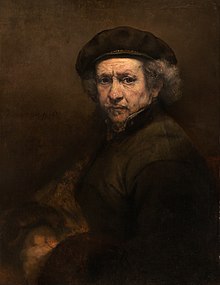Rembrandt Van Rijn (1606-1669)was bon in Leiden on July 15, 1606 - his full name Rembrandt Harmenszoon van Rijn. Rembrandt began his studies at the Latin School, and at the age of 14 Rembrandt Van Rijn (1606-1669)was enrolled at the University of Leiden. The program did not interest him, and he soon left to study art - first with a local master, Jacob van Swanenburch, and then, in Amsterdam, with Pieter Lastman, known for his historical paintings
Rembrandt Van Rijn (1606-1669) was bon in Leiden on July 15, 1606 - his full name Rembrandt Harmenszoon van Rijn. Rembrandt began his studies at the Latin School, and at the age of 14 Rembrandt Van Rijn (1606-1669)was enrolled at the University of Leiden. The program did not interest him, and he soon left to study art - first with a local master, Jacob van Swanenburch, and then, in Amsterdam, with Pieter Lastman, known for his historical paintings
Rembrandt moved to Amsterdam in 1631; his marriage in 1634 to Saskia van Uylenburgh, the cousin of a successful art dealer, enhanced his career, bringing him in contact with wealthy patrons who eagerly commissioned portraits.
Rembrandt produced many of his works in this fashionable town house in Amsterdam. Purchased by the artist in 1639, when he was 33, it proved to be the scene of personal tragedy: his wife and three of his children died here. The house became a financial burden, and in 1660 Rembrandt was forced to move. A new owner added the upper story and roof, giving it the appearance it still bears. In 1911 the Dutch movement made it a Rembrandt museum -preserving it both as a shrine of a revered national artist and as an imposing example of 17th Century Dutch architecture.
In contrast to his successful public career, however, Rembrandt's family life was marked by misfortune. Despite Rembrandt's financial success as an artist, teacher, and art dealer, his penchant for ostentatious living forced him to declare bankruptcy in 1656. An inventory of his collection of art and antiquities, taken before an auction to pay his debts, showed the breadth of Rembrandt's interests: ancient sculpture, Flemish and Italian Renaissance paintings, Far Eastern art, contemporary Dutch works, weapons, and armor. Unfortunately, the results of the auction - including the sale of his house - were disappointing.
These problems in no way affected Rembrandt's work; if anything, his artistry increased. Some of the great paintings from this period are The Jewish Bride (1665), The Syndics of the Cloth Guild (1661, Rijksmuseum, Amsterdam), Bathsheba (1654, Louvre, Paris), Jacob Blessing the Sons of Joseph (1656, Staatliche Gemäldegalerie, Kassel, Germany), and a self-portrait (1658, Frick Collection). His personal life, however, continued to be marred by sorrow. His beloved Hendrickje died in 1663, and his son, Titus, in 1668- only 27 years of age. Eleven months later, on October 4, 1669, Rembrandt died in Amsterdam.
